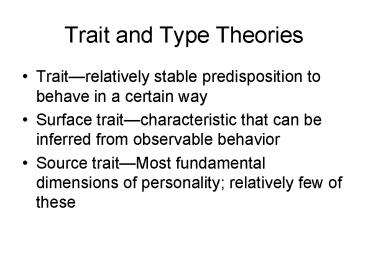Trait and Type Theories - PowerPoint PPT Presentation
1 / 10
Title:
Trait and Type Theories
Description:
Source trait Most fundamental dimensions of personality; relatively few of these ... Source traits. Represent the basic dimensions of personality. Hans Eysenck ... – PowerPoint PPT presentation
Number of Views:1703
Avg rating:3.0/5.0
Title: Trait and Type Theories
1
Trait and Type Theories
- Traitrelatively stable predisposition to behave
in a certain way - Surface traitcharacteristic that can be inferred
from observable behavior - Source traitMost fundamental dimensions of
personality relatively few of these
2
Theorists
- Gordon Allport Cardinal Traits
- Raymond Cattell16 PF
- Hans EysenckThree-factor model
- McCrae and CostaFive-factor model
3
Trait Approaches
- Trait theory
- Assumption that all people possess certain traits
- Traits
- Enduring dimensions of personality characteristics
4
Allports Trait Theory
- Cardinal trait
- A single characteristic that directs most of a
persons activities - Central trait
- The major characteristic of an individual
- Secondary trait
- Characteristics that affect behavior in fewer
situations and are less influential than central
or cardinal traits
5
Raymond Cattell
- Used factor analysis to come up with 16 basic
personality traits also called source traits - 16-PF test that was developed to measure these
traits - Generally considered as too many traits
6
Trait Approaches
- Cattell
- Factor analysis
- A method of summarizing the relationships among a
large number of variables into fewer, more
general patterns - Source traits
- Represent the basic dimensions of personality
7
Hans Eysenck
- Similar method to Cattell
- Had 3 different source traits
- Introversion-extraversion
- Neuroticism-stability
- Psychoticism
- Generally considered to have too few traits
8
Trait Approaches
- Hans Eysenck
- Extraversion, neuroticism, and psychoticism
- The Big Five
- Openness to experience
- Conscientiousness
- Extraversion
- Agreeableness
- Neuroticism
9
Five Factor Model
- Described somewhat differently among researchers
- Factorsusually rated from low to high
- Extraversion
- Neuroticism
- Openness to experience
- Agreeableness
- Conscientiousness
10
Evaluation of Trait Perspective
- Dont really explain personality, simply describe
the behaviors - Doesnt describe the development of the behaviors
- Trait approaches generally fail to address how
issues such as motives, unconscious, or beliefs
about self affect personality development































